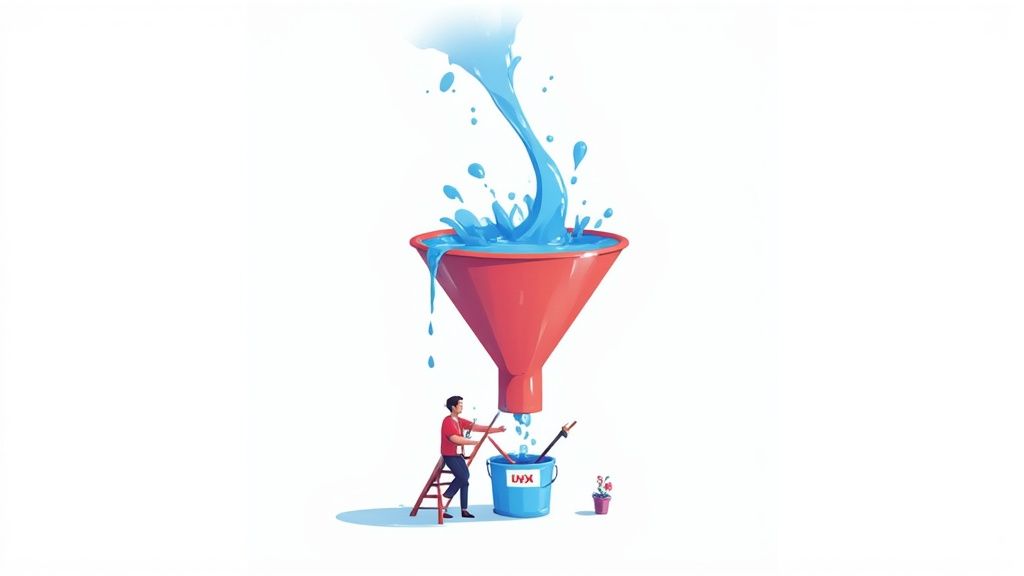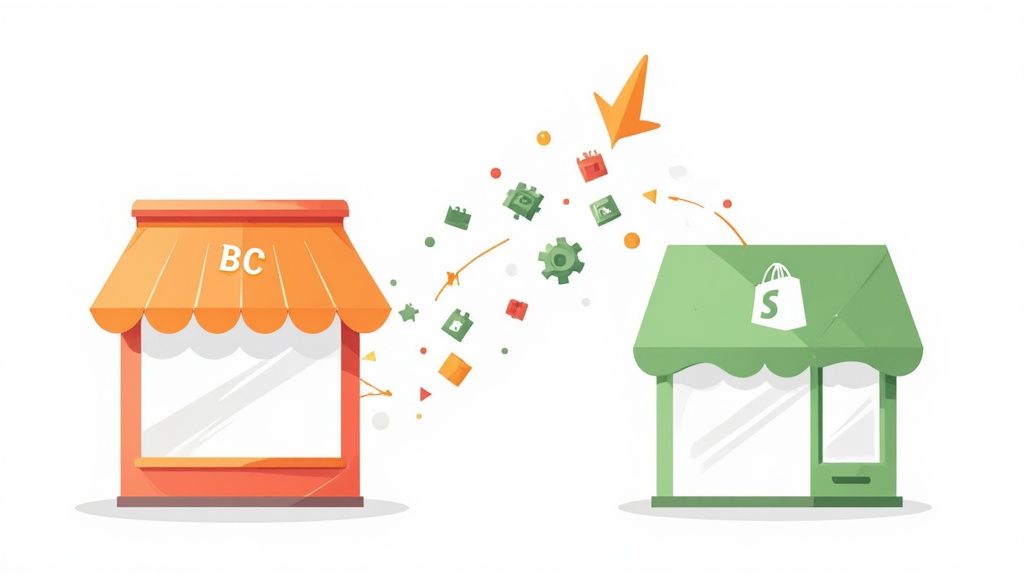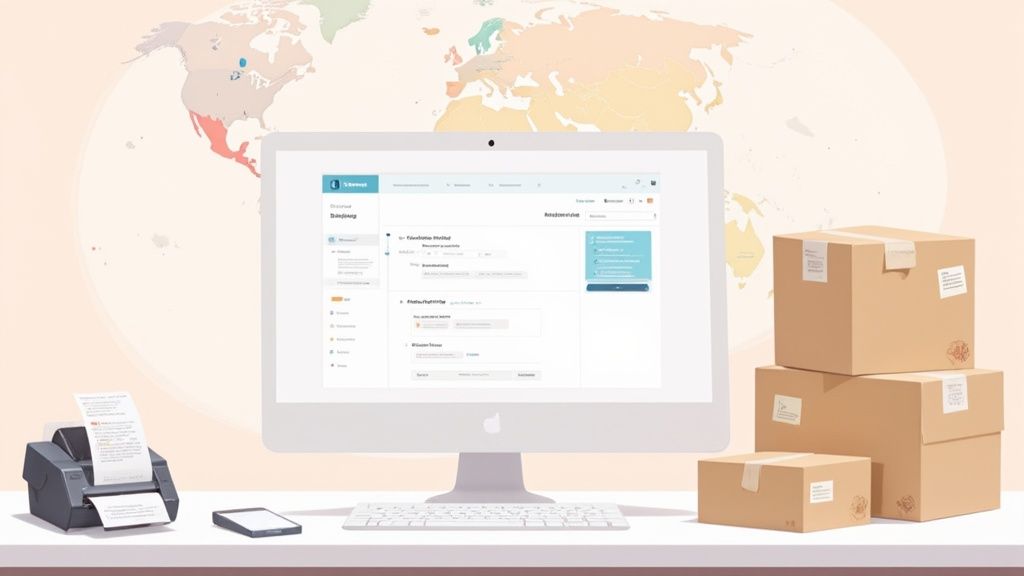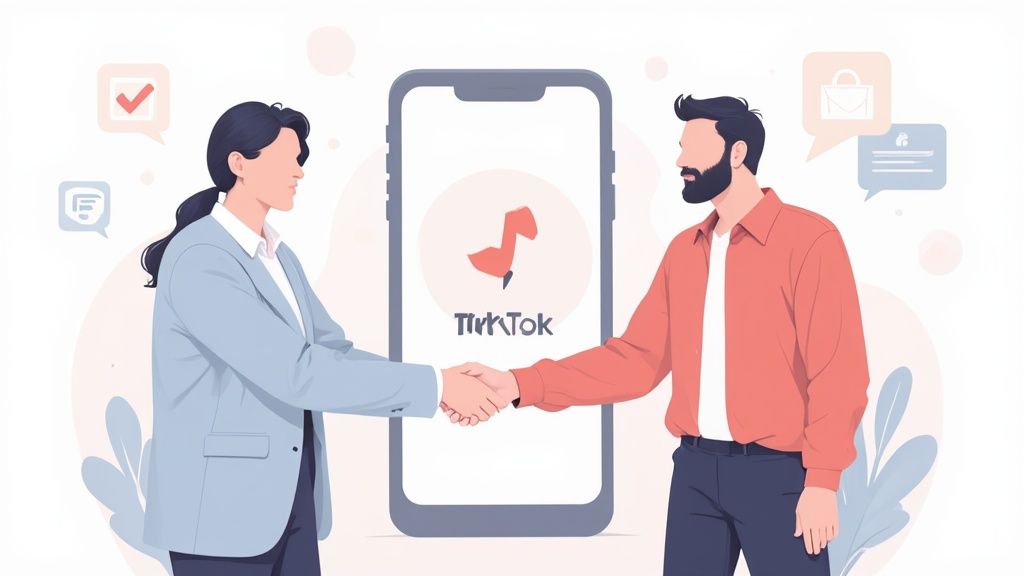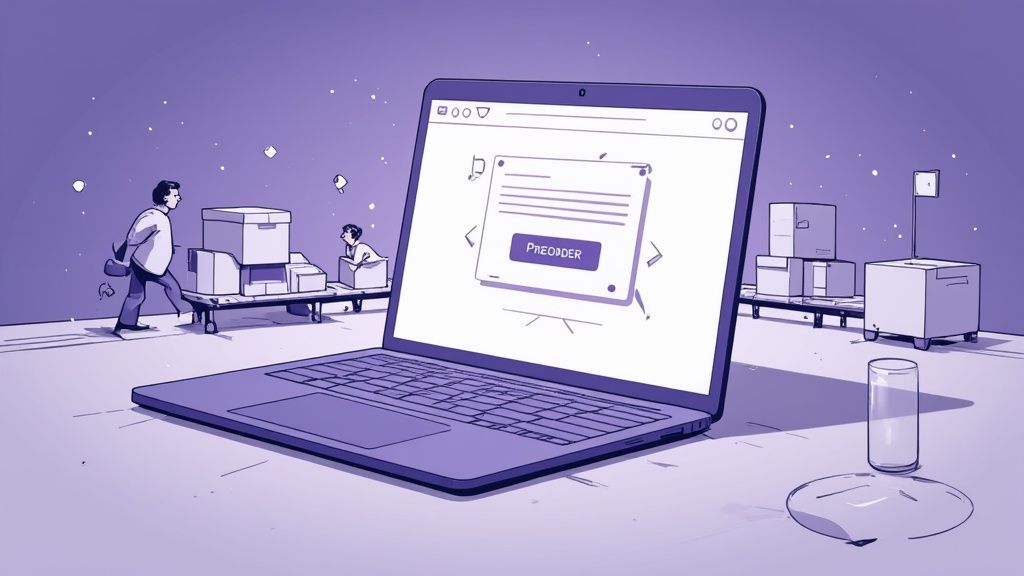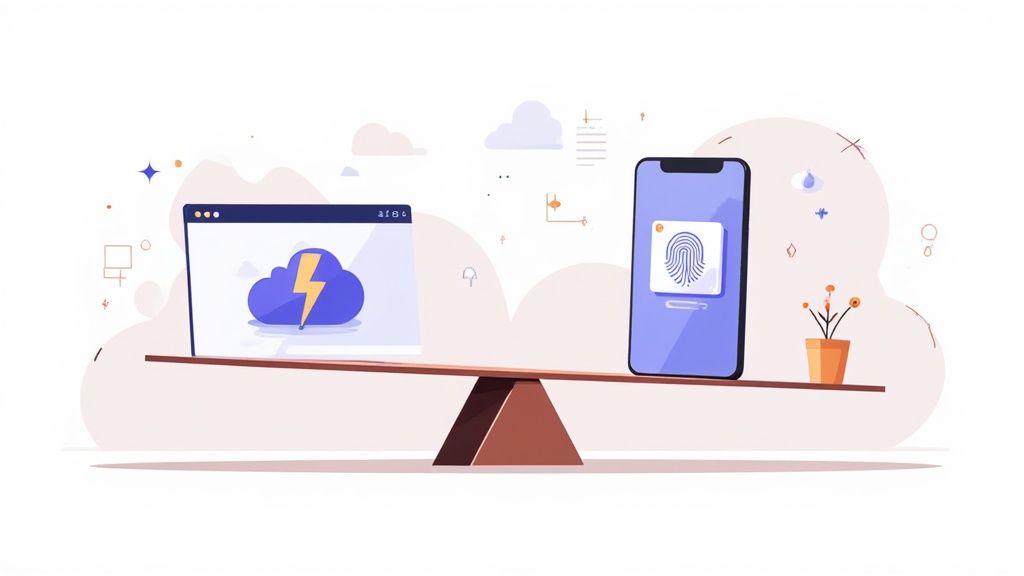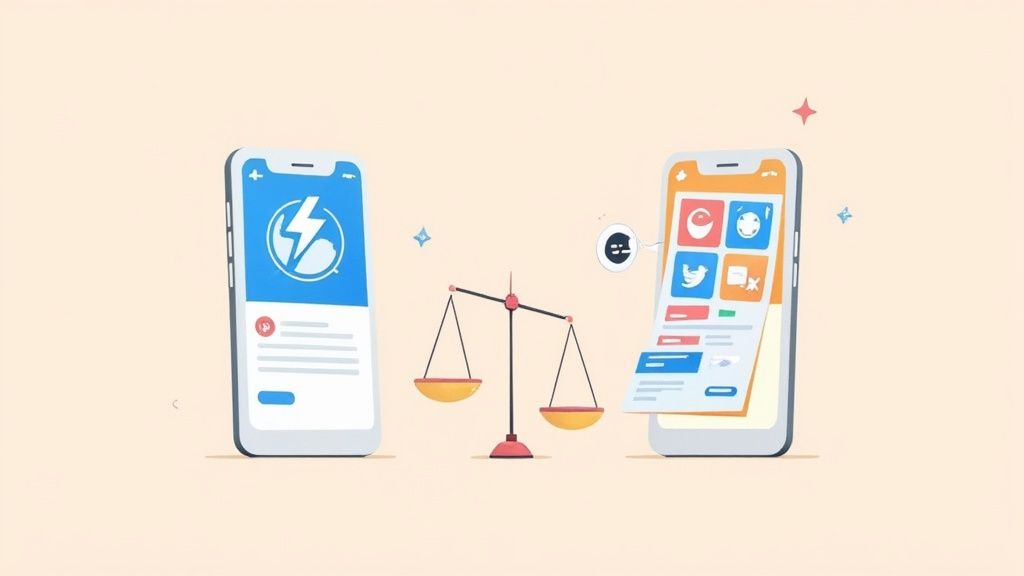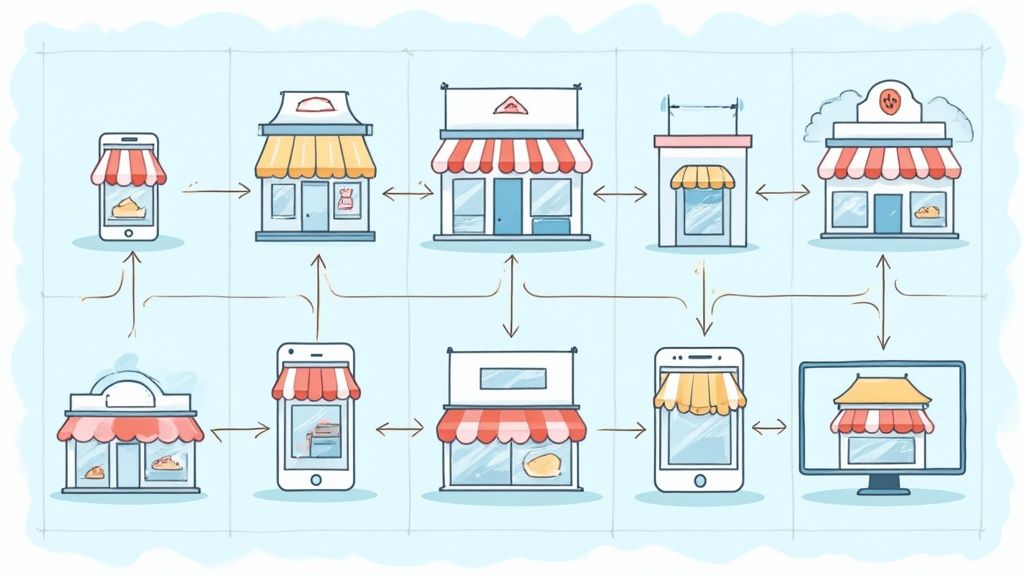
Responding to a bad review isn't just about damage control. It’s about publicly acknowledging a customer's feedback, genuinely apologizing for their poor experience, and offering a clear path to make things right, usually by taking the conversation offline. This single action sends a powerful message not only to the unhappy customer but to every potential customer who's watching.
Why You Must Respond to Every Bad Review

Ignoring a negative review is like hanging up the phone on an angry customer right in the middle of a packed store. Everyone sees it, and your silence is deafening. A complaint used to be a private conversation. Now, it's a public performance with your brand’s reputation on the line. Every unanswered 1-star review slowly erodes the trust you've worked so hard to build.
The Psychology of a Public Reply
When a customer posts negative feedback, they’re usually looking for two things: validation and a resolution. They want to feel like you've heard them and are actually taking their problem seriously. A thoughtful, public reply hits both targets. It validates their feelings by acknowledging their frustration and shows you're committed to fixing it.
But this is more than just putting out a fire; it’s a golden opportunity. While your reply is for one person, the audience is every future customer doing their homework on your business. They’re watching closely to see how you handle conflict and treat people when things go wrong.
The Expectation Gap and Its Impact
There's a massive gap between what customers expect and what most businesses actually do. By 2025, 53% of consumers expect a reply to their negative review within a week. The shocking part? A staggering 87% of businesses don't respond at all.
This disconnect is a huge missed opportunity, especially when you consider that 89% of customers actively read business responses and 64% are more likely to buy from companies that engage with reviewers. Just by replying, you can stand out from nearly all of your competitors. If you're curious, you can explore more review statistics to see just how much they affect your bottom line.
The simple act of responding to feedback has a direct and measurable impact on your business. Ignoring it is a choice with its own set of consequences.
Responding vs Ignoring Negative Feedback
Ultimately, choosing to engage is choosing to invest in your brand's reputation and financial health. The data makes it clear that the cost of silence is far greater than the effort of a thoughtful reply.
Responding isn’t about winning an argument; it’s about showcasing your character. A calm, professional, and helpful reply can transform a public complaint into a testament to your excellent customer service, building trust far more effectively than a page full of perfect five-star ratings ever could.
A Practical Framework for Your Response
Ditching the generic, copy-paste replies is the first step. Seriously, customers can spot them from a mile away. Instead of a rigid script, you need a flexible framework that hits all the right notes. I've always used a simple, memorable approach I call the 4 A's: Acknowledge, Apologize, Act, and Advance. It’s a reliable mental checklist that helps craft genuine, professional responses every time.
Remember, your first public reply isn't about solving the entire problem right then and there. It's about validating the customer's feelings and showing them you're actually listening.
Acknowledge and Apologize
The first two steps, Acknowledge and Apologize, are your go-to for disarming frustration. They have to work together.
Acknowledging their experience shows you’ve read their complaint, not just skimmed it. Get specific. Instead of a bland, "We're sorry you had a bad experience," try something like, "It’s really concerning to hear that your order arrived late and the packaging was damaged." See the difference? It proves you’re paying attention.
Next comes the apology. This is non-negotiable. It doesn’t always mean you’re admitting legal fault, but you are expressing regret that their experience was poor. A simple, "We're genuinely sorry that we fell short of your expectations and for the frustration this caused," can work wonders. You're building a bridge of empathy before you even talk about a solution.
A powerful apology focuses on the customer's feelings, not the company's excuses. Expressing regret for their disappointment is a non-negotiable step that shows respect and immediately lowers their defenses, making them more receptive to a resolution.
This infographic breaks down the flow of a solid response.

As you can see, the path from complaint to resolution starts with empathy and ends with real action.
Act and Advance
Once you’ve made it clear you understand their frustration, it’s time to Act. This is where you outline the concrete steps you're taking to look into the problem. Be transparent. For example, you might say, "We are reviewing our shipping procedures with our fulfillment partner to find out what went wrong here." This shows you’re committed to fixing things, not just offering empty words.
Finally, you need to Advance the conversation offline. The public review section is for showing accountability, not for hashing out order numbers and personal details. Wrap up your reply by inviting the customer to a private channel.
- Provide a direct contact: "Please email our support lead, Jane, at help@yourcompany.com so we can get the details to arrange a replacement."
- Set clear expectations: "We want to make this right. If you could reach out to us with your order number, our team will get this sorted for you immediately."
This final step protects your customer's privacy and gives you the space to find a real solution. It effectively turns a public complaint into a productive, private conversation.
Real-World Review Scenarios and Responses

Okay, templates and theory are a great starting point, but the real test comes when you’re staring at a genuinely unhappy customer's review on your screen. This is where the rubber meets the road. Let’s walk through a couple of common (and sometimes tricky) scenarios you’ll definitely run into.
You have to remember that every situation calls for its own unique touch. A customer whose product showed up in pieces needs a far different response than someone who just didn't vibe with your store's atmosphere. The trick is to tailor your tone and solution while sticking to those core principles: empathy and accountability.
Let's break down two frequent situations with clear examples of what to do, and what will just pour fuel on the fire.
Scenario 1: Product Arrived Broken
This one’s a classic service failure. The customer paid for something they can’t use, and they have every right to be upset. Your only goal here is to apologize sincerely and make it right—fast.
❌ Don't do this:"We are sorry for the inconvenience. Our shipping partners sometimes mishandle packages. Please go to our website and fill out a return form to start the exchange process."
This response is just cold. It passes the blame and, worse, gives an already frustrated customer a homework assignment. It completely lacks any real empathy.
✅ Do this instead:"Hi Sarah, we are so sorry to hear your item arrived damaged. That is completely unacceptable and not the standard we hold ourselves to. We're shipping you a replacement today, on us—no need to worry about returning the broken one. Could you please confirm your shipping address at help@yourcompany.com? We'll also be looking into this with our shipping team to prevent it from happening again."
See the difference? This reply takes 100% ownership, apologizes with feeling, and offers a solution that’s immediate and hassle-free.
Scenario 2: A Subjective Complaint
Sometimes, the feedback isn't about a clear failure but a mismatch in expectations. Think of a customer complaining about your store's music or a restaurant's ambient lighting. You can't exactly "fix" their personal taste, but you absolutely can—and should—validate their experience.
For a deeper look into how brand perception and atmosphere play a huge role, check out this case study on brand strategy for Richard Tea.
❌ Don't do this:"We're sorry you didn't like the music. Most of our customers love our playlist."
This is incredibly dismissive. You're essentially telling the customer their opinion is wrong, which is a surefire way to make them feel unheard and defensive.
Acknowledging a customer's feelings doesn't mean you agree with their opinion. It means you respect their right to have it. Validation is a powerful tool for de-escalation, even when you can't change the core issue they're complaining about.
✅ Do this instead:"Hi Mark, thank you for sharing your feedback about the atmosphere. We're sorry to hear the music wasn't to your taste and impacted your visit. We really appreciate you letting us know, as we're always looking for ways to create a more welcoming environment for everyone."
This response is perfect. It's respectful and validating. You thank them for their input without getting defensive, leaving a positive impression on both the reviewer and anyone else reading it.
Tools and Automation for Managing Reviews

As your business grows, manually keeping tabs on Google, Yelp, Facebook, and a dozen other sites for new feedback becomes a logistical nightmare. You know responding to bad reviews quickly is a must, but it can't eat up your entire day. This is where you need to get smart and build a scalable system with the right tools. It's about efficiency and, frankly, your own sanity.
A dedicated reputation management platform is a total game-changer. Think of it as a central command center that pulls all your reviews from every corner of the web into a single, clean dashboard. No more logging into five different accounts just to see what's new. That consolidation alone will feel like you've reclaimed hours of your week.
Streamlining Your Response Workflow
But where these tools really shine is automation. You can set up instant alerts that ping you on email or Slack the second a new review drops. This ensures that no piece of feedback—especially a fiery one—ever slips through the cracks. We know that timeliness matters. In fact, 53% of customers expect a response within a week, and a faster reply shows you’re on top of your game and genuinely listening.
You can get even smarter with your workflows. For example, you could:
- Automatically triage reviews. Set up rules to immediately flag all 1- and 2-star reviews and assign them to a senior team member for a priority response.
- Build a template library. Create a collection of pre-approved response starters for common issues. This isn't about firing off robotic replies; it's about giving your team a solid, on-brand foundation to customize for each situation.
The point of automation isn't to replace the human touch in responding to bad reviews. It’s to handle the repetitive, time-sucking tasks so your team can pour their energy into crafting the thoughtful, personalized, and empathetic responses that actually win customers back.
Balancing AI with a Human Touch
Many modern reputation management platforms now come with AI-powered response generators. These can be incredibly useful for getting the ball rolling and creating a first draft. The AI can analyze the review's sentiment and key points to suggest a relevant reply that already follows best practices.
But—and this is a big but—the final word must always be human. Your team needs to take that AI-generated draft, sprinkle in specific details from the customer’s actual experience, and infuse it with your brand’s authentic voice. This blended approach gives you the speed of automation without sacrificing the genuine connection that only a real person can provide.
Turning Feedback into Business Intelligence
Handling bad reviews one by one is a must, but the real magic happens when you start connecting the dots. Think of each piece of feedback, especially the negative stuff, as a breadcrumb leading you straight to a weak spot in your business. Your job is to transform these individual complaints into a serious source of business intelligence.
So, how do you do it? Start by tracking the patterns in your negative feedback. Are several customers griping about slow shipping? Is one of your products consistently showing up damaged? These aren't just one-off problems; they're data points screaming that something's wrong with your system. By logging and spotting these trends, you can stop just saying sorry and start fixing the root cause, whether that’s a dodgy supplier or a bug on your website.
Leveraging Feedback for Growth and Recovery
This isn't just about making customers happy; it's about making your business healthier. The numbers don't lie: negative reviews convince 86% of consumers to steer clear of a business. But on the flip side, just a single-star bump in your rating can increase revenue by 5-9%. And since 68% of people make up their mind after reading only a handful of reviews, every single response counts. You can learn more about the impact of online review stats to see just how much this stuff matters.
Turning a critic into an advocate is one of the most powerful marketing moves you can make. After you've successfully resolved an issue offline, a polite follow-up can make all the difference.
Consider sending a simple, no-pressure message like: "We're so glad we could resolve this for you. If you feel we've earned it, we would appreciate you considering an update to your review." This shows respect and leaves the ball in their court, protecting your integrity while giving you a shot at flipping that negative rating. Solving problems and encouraging updated feedback are core strategies to increase customer retention and build loyalty.
What about those reviews that are obviously fake or break the rules? Use the platform's flagging or reporting feature. But while you wait for the platform to act, it’s usually a good idea to post a calm, public reply. Something simple like, "We have no record of this customer or transaction, but we'd love to help. Please contact us directly so we can look into it." This shows other potential customers you’re on the ball without getting dragged into a messy public fight.
Even with the best game plan, tricky situations will pop up that leave you scratching your head. Let's walk through some of the most common questions I hear from business owners about handling bad reviews and give you some clear, road-tested answers.
What Should I Do If a Review Is Completely False?
We've all been there. You get a one-star review from someone you've never done business with. It happens.
If a review is provably false or blatantly violates a platform's rules (like spam or hate speech), your first move should always be to report it. While you wait for the platform to take action—which can sometimes take a while—it's still a good idea to post a calm, professional public reply.
This shows other potential customers that you're on top of things. You don't need to get into a mud-slinging match.
A simple, tactful response works wonders. Something like, "We take all feedback seriously, but we have no record of this customer or transaction in our system. We encourage the reviewer to contact our team directly with more details so we can look into this," is perfect. It politely questions the review's legitimacy without starting a public fight.
This approach keeps you looking professional while signaling to other readers that something might be off.
How Quickly Must I Respond?
Honestly, the sooner, the better. You should really aim to reply to any negative feedback within 24-48 hours. While some studies suggest customers are okay waiting up to a week, a fast response shows you're paying attention and you actually care.
Acting quickly can de-escalate a heated situation before it spirals. It also prevents that negative comment from just sitting there, unanswered, poisoning the well for countless other potential buyers. A reply that comes a week later often feels more like a chore than a genuine attempt to help.
Should I Offer Refunds in a Public Response?
This is a big one. As a general rule, you should avoid offering specific compensation like refunds or discounts in your public reply. It’s a slippery slope. Once you do it publicly, you might find more people leaving negative reviews hoping for a freebie.
Instead, your public response should be all about moving the conversation to a private channel to find a solution.
- Acknowledge their issue with genuine empathy.
- Show them you’re ready and willing to fix it.
- Give them a clear, easy way to contact you privately.
For example: "We're so sorry to hear about your experience and we are committed to making this right. Please reach out to our support team at [email/phone number] so we can find the best possible resolution for you." This shows you're taking action without opening the floodgates for public compensation demands.
Managing your online reputation is one part smart strategy, one part solid technical foundation. At ECORN, we build and optimize Shopify stores that don't just look incredible—they're engineered to foster strong customer relationships and drive real growth. Discover how our Shopify expertise can help your brand thrive.












